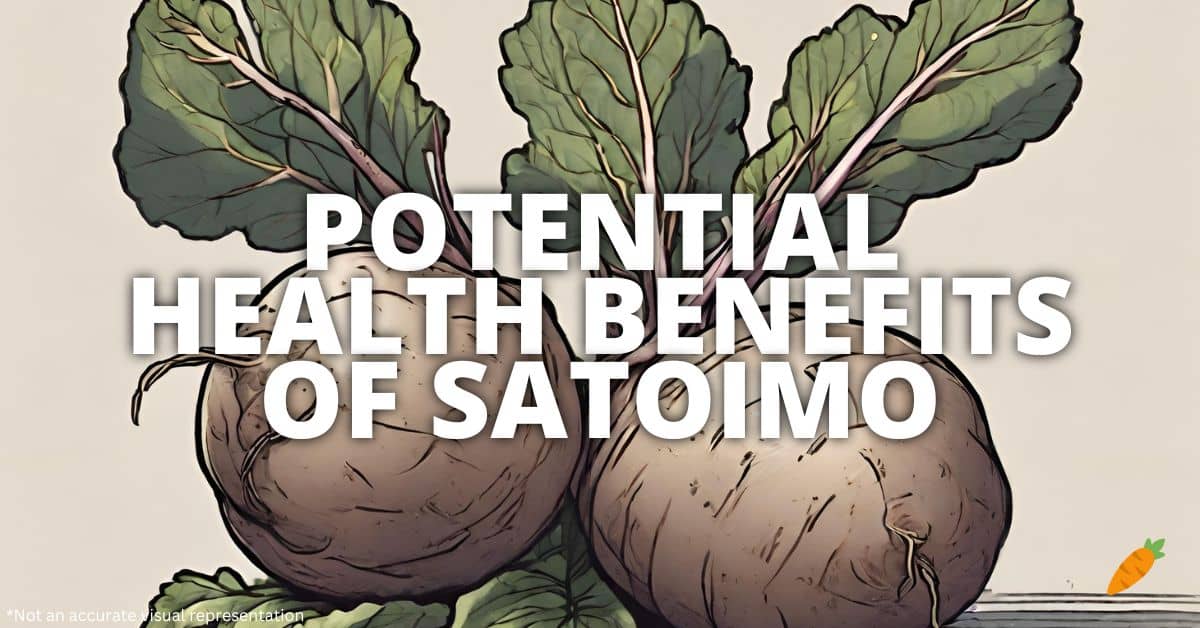Satoimo, known internationally as taro root, is a staple food in many parts of Asia, celebrated for its versatility and health benefits.
This root vegetable is distinguished by its unique, nutty flavor and a texture that becomes creamy when cooked.
Rich in a variety of nutrients, satoimo is an excellent source of dietary fiber, vitamins, and minerals, contributing to overall health and well-being.
Its cultivation dates back thousands of years, making it a crucial component of traditional diets.
By incorporating satoimo into modern meals, individuals can enjoy a connection to cultural heritage while reaping significant health rewards.
1. Nutritional Value of Satoimo: More Than Just a Root
Satoimo, known as Japanese sweet taro, is a starchy root vegetable that has been a staple in Japanese cuisine for centuries.
Its nutritional profile is indeed impressive, as it provides a wealth of essential nutrients critical for maintaining good health, functioning similarly to how a yam might in other diets but with its unique benefits.
Notably, it is particularly high in vitamin C, a key nutrient for immune function, potassium, which supports heart health, and magnesium, essential for muscle function.
In addition to these nutrients, the root also offers a good amount of manganese and copper.
These trace minerals are vital for bone health and play important roles in protecting the body against oxidative stress, respectively.
Despite its starchy nature, satoimo is relatively low in calories, making it an excellent choice for individuals monitoring their calorie intake.
Furthermore, thanks to its high content of complex carbohydrates, satoimo ensures a slow and steady release of energy.
This attribute is beneficial for managing blood sugar levels, preventing the spikes often associated with simpler carbohydrates.
📙 Potential Health Benefits Of Sansai
2. Satoimo as a Rich Source of Fiber
Satoimo, often celebrated for its high fiber content, stands out as a pivotal element in fostering a well-rounded and nutritious diet.
This root vegetable, rich in both soluble and insoluble fiber, is instrumental in enhancing digestive wellness, supporting regular bowel movements, and mitigating constipation risks.
Its substantial fiber makeup not only aids in digestion but also significantly contributes to satiety, thereby playing a vital role in weight management strategies by helping to curb appetite and reduce overall calorie consumption.
The soluble fiber present in satoimo is particularly effective in managing cholesterol levels, as it binds with cholesterol particles in the digestive tract, facilitating their removal from the body and thus promoting cardiovascular health.
Furthermore, the fiber acts as a prebiotic, nourishing the beneficial gut flora, which is essential for maintaining a balanced and healthy gut microbiome.
Cultivating satoimo in one’s diet not only leverages its high fiber benefits but also taps into its starch content, offering a sustained energy source that is integral for daily activities.
Integrating satoimo into meals can therefore significantly contribute to overall health, making it a valuable addition to a health-conscious lifestyle.
📙 Potential Health Benefits Of Watercress
3. Potential Health Benefits of Satoimo in Regulating Blood Sugar Levels
Satoimo, which is high in fiber, stands out as a healthier alternative to traditional starchy foods like sweet potatoes, offering substantial benefits in regulating blood sugar levels.
Its low glycemic index is instrumental in moderating blood sugar spikes, making it an ideal dietary option for individuals monitoring their glucose levels, including those with diabetes.
The high fiber content in satoimo not only slows glucose absorption, ensuring a gradual release of energy but also contributes to a feeling of satiety, which can aid in weight management by reducing the likelihood of overeating.
Moreover, incorporating satoimo into meals can provide a sustained energy supply, helping to eliminate the energy dips that often follow the consumption of meals high in simple sugars or starch.
This attribute is particularly beneficial for individuals looking to maintain steady energy levels throughout the day without resorting to sugary snacks.
The fiber in satoimo also supports digestive health, further emphasizing its role in a balanced diet.
By opting for satoimo, possibly prepared with flavors like soy sauce for a nutritious dish, individuals can enjoy a delicious, high-fiber meal that supports blood sugar control and overall health.
📙 Potential Health Benefits Of Oriental Pickling Melon
4. The Role of Satoimo in Reducing Inflammation
Satoimo is renowned not just for its nutritional benefits but also for its anti-inflammatory properties, thanks to its rich antioxidant content.
These antioxidants, such as vitamin C and polyphenols, help neutralize free radicals in the body, reducing oxidative stress and inflammation.
Chronic inflammation is a root cause of numerous health issues, including arthritis, heart disease, and certain cancers.
By incorporating satoimo into one’s diet, individuals may experience a decrease in inflammation-related symptoms and a lower risk of developing chronic diseases.
Its anti-inflammatory effects make satoimo an excellent dietary choice for those looking to improve their overall health and prevent inflammation-induced conditions.
📙 Potential Health Benefits Of Nanohana
5. Satoimo and Its Impact on Cholesterol Levels
Incorporating satoimo into your diet can have a positive impact on cholesterol levels, thanks to its high fiber content.
This fiber binds with cholesterol in the digestive system, facilitating its excretion from the body and thereby lowering overall cholesterol levels.
Regular consumption of satoimo can lead to a reduction in LDL (bad) cholesterol and an increase in HDL (good) cholesterol, contributing to a healthier cardiovascular system.
The reduction of cholesterol levels through natural dietary choices like satoimo minimizes the risk of developing heart disease and stroke.
Therefore, satoimo is not only a nutritious food option but also a natural way to manage and improve heart health.
📙 Potential Health Benefits Of Myoga
6. Boosting the Immune System with Satoimo
Satoimo’s vitamin C content plays a pivotal role in boosting the immune system, enhancing the body’s ability to fight off infections and diseases.
Vitamin C stimulates the production and function of leukocytes (white blood cells), which are crucial for defending the body against pathogens.
Furthermore, the antioxidants in satoimo support the immune system by protecting cells from oxidative damage and supporting the body’s natural defense mechanisms.
By improving gut health through its fiber content, satoimo also contributes to a robust immune system, as a significant portion of the immune system is located in the gut.
Thus, regular consumption of satoimo can be a strategic dietary approach to enhancing immune function and maintaining overall health.
📙 Potential Health Benefits Of Mung Bean Sprout
7. Enhancing Cognitive Function Through Satoimo Consumption
Satoimo’s contribution to brain health is significant, with nutrients that support cognitive functions and mental acuity.
Its vitamin E and potassium content, in particular, play essential roles in cognitive health by protecting neuronal cells from oxidative stress and ensuring proper nerve function.
These nutrients have been associated with reduced risks of cognitive decline and neurodegenerative diseases such as Alzheimer’s and Parkinson’s.
The complex carbohydrates in satoimo provide a steady source of energy for the brain, supporting concentration and memory functions.
Integrating satoimo into one’s diet may contribute to improved cognitive performance and a reduced risk of age-related cognitive impairments.
📙 Potential Health Benefits Of Mizuna
8. Satoimo for Bone Health: A Key Contributor
Satoimo’s nutrient composition includes calcium and magnesium, vital minerals for bone density and strength.
These minerals facilitate the growth and maintenance of bones, reducing the risk of osteoporosis and other bone-related disorders as one age.
Beyond calcium and magnesium, satoimo also provides vitamin K, which plays a crucial role in bone metabolism and the prevention of bone fractures.
Regular consumption of satoimo contributes to a balanced diet that supports skeletal health and prevents the degradation of bone tissue.
Therefore, including satoimo in the diet is a proactive approach to ensuring long-term bone health and reducing the incidence of bone diseases.
📙 Potential Health Benefits Of Matteuccia
9. Nutrition Facts of Satoimo: A Comprehensive Overview
Satoimo stands out for its low-calorie yet nutrient-dense profile, making it an ideal food choice for those looking to maintain or lose weight without sacrificing nutritional intake.
It provides a complex carbohydrate source that releases energy slowly, keeping you fuller for longer and helping to manage hunger and blood sugar levels.
This root vegetable is also a good source of essential vitamins and minerals, including B vitamins, which are critical for energy metabolism, and iron, which is necessary for blood health.
The inclusion of satoimo in one’s diet can enhance dietary diversity, bringing a range of micronutrients important for overall well-being.
Its balance of nutrients supports not just physical health but also stabilizes energy levels throughout the day.
📙 Potential Health Benefits Of Lotus Root
10. Satoimo: A Versatile Ingredient in Healthy Cooking
The culinary versatility of satoimo allows it to be incorporated into a wide array of dishes, from soups and stews to desserts and snacks.
Its naturally creamy texture and mild, slightly sweet flavor make it a popular ingredient in both savory and sweet culinary creations.
When cooked, satoimo can be mashed, baked, fried, or boiled, offering a healthier alternative to potatoes and other starchy vegetables.
Its adaptability in recipes makes it easy to include in daily meals, thereby ensuring that individuals can benefit from its nutritional properties in a variety of ways.
Experimenting with satoimo in the kitchen not only adds nutritional value to meals but also introduces new flavors and textures to the dining experience.
📚 Satapang Beauty (Produk Sabun Talas Jepang/Satoimo)
💡 Conclusion
Satoimo, with its comprehensive nutritional benefits and potential health impacts, is more than just a staple food; it’s a superfood that supports various aspects of health, from blood sugar regulation and inflammation reduction to cardiovascular health and cognitive function.
Its rich array of nutrients and health-promoting properties makes it a valuable addition to any diet, contributing to overall well-being and disease prevention.
As a versatile and flavorful ingredient, satoimo offers a unique opportunity to enhance the nutritional quality of meals while exploring new culinary possibilities.
Embracing satoimo in the diet is not only a step towards healthier eating habits but also an investment in long-term health and wellness.
⛑️ Safety First
While satoimo (taro root) is celebrated for its potential health benefits, including improved digestion, blood sugar regulation, and immune support, it is crucial to note safety precautions when handling and consuming this root vegetable.
Raw satoimo contains calcium oxalate, which can cause skin irritation and a burning sensation in the mouth and throat if ingested without proper cooking.
Therefore, it is essential to wear gloves when peeling and to thoroughly cook satoimo to neutralize these compounds.
Individuals with kidney issues should consume satoimo with caution due to its oxalate content, which can contribute to kidney stone formation in susceptible individuals.
Lastly, as with any dietary change, it’s recommended to introduce satoimo gradually to observe how your body responds, especially if you have food sensitivities or allergies.
⚠️ Content Disclaimer
The content provided herein is for informational purposes only and is not intended as medical advice, diagnosis, or treatment.
Readers are advised to consult a qualified health professional before making any health-related decisions or if they have specific concerns about their health.
The information and opinions expressed in this document are based on research and literature available at the time of writing and may not account for the latest scientific discoveries or medical advancements.
The author and publisher disclaim any liability for any adverse effects arising directly or indirectly from the use of the information contained in this document.
Reliance on any information provided by this content is solely at the reader’s own risk.

